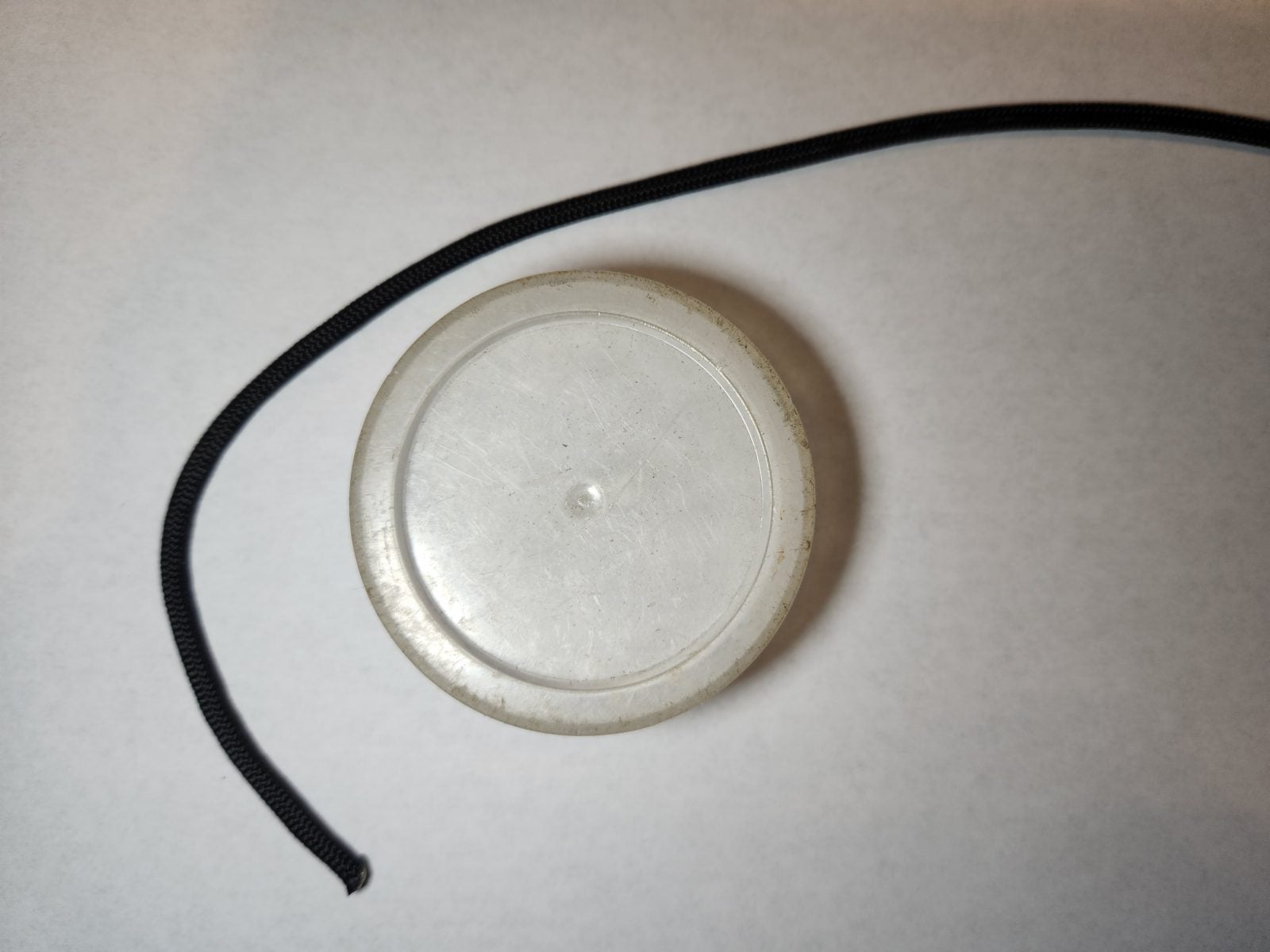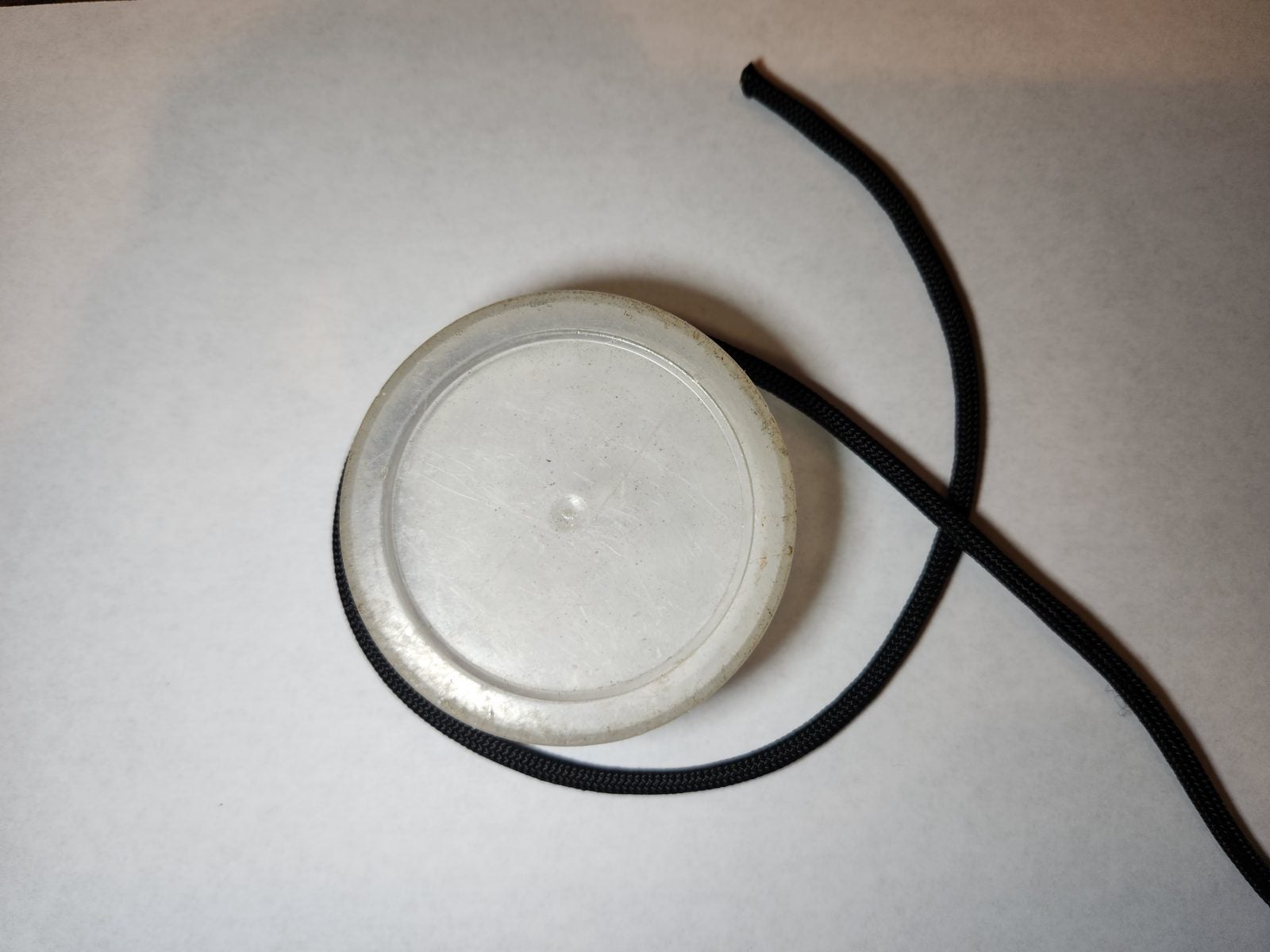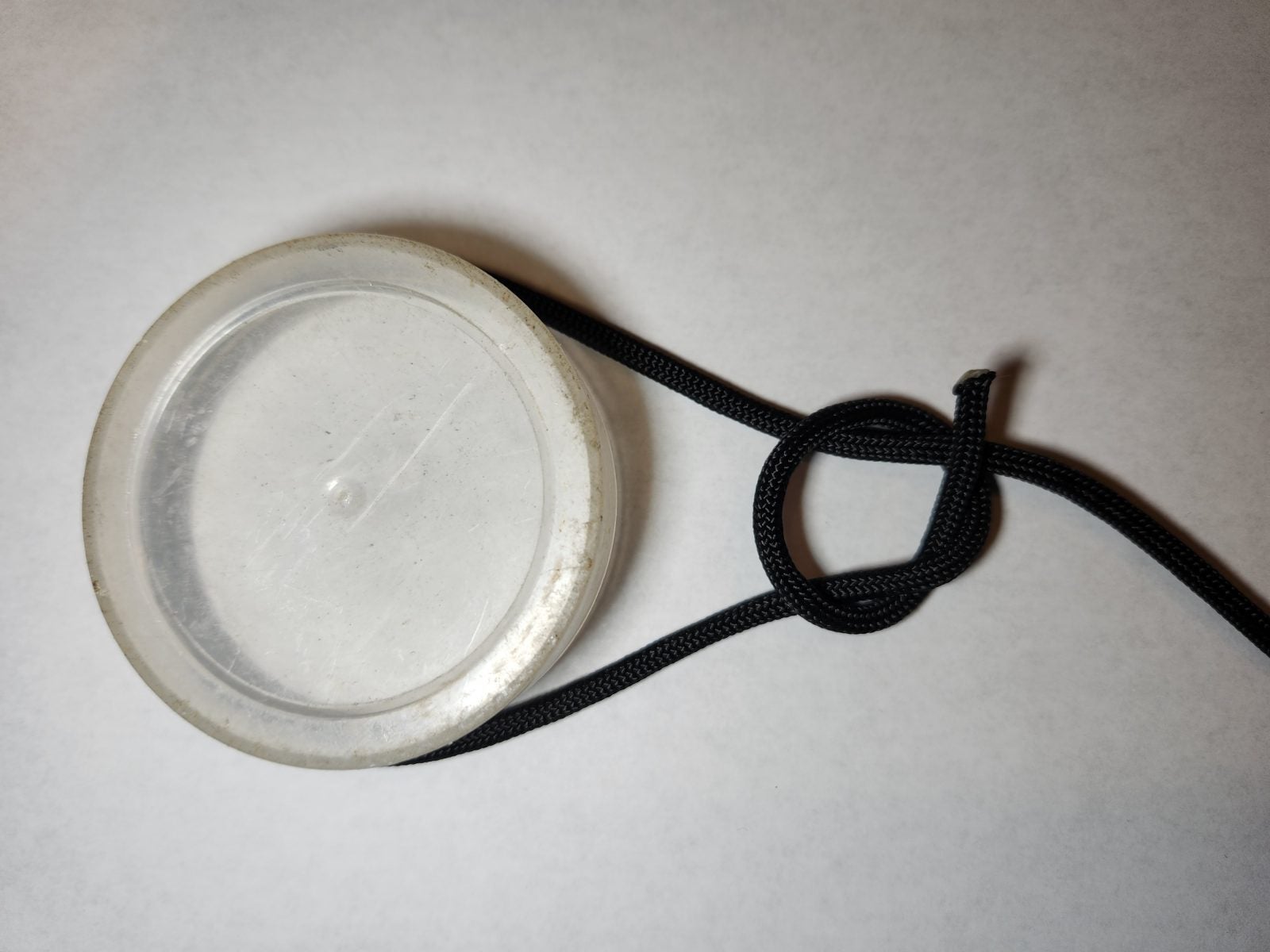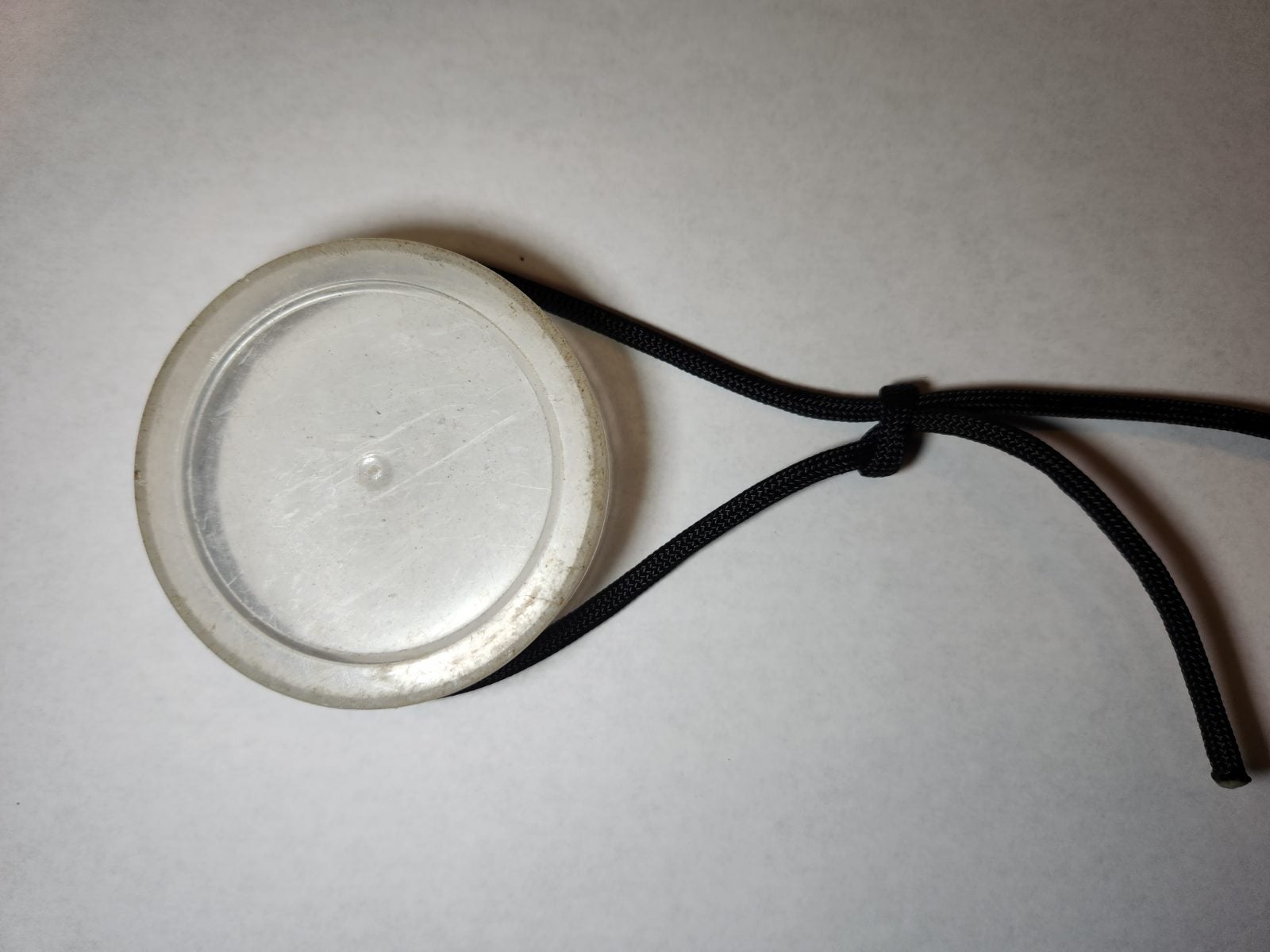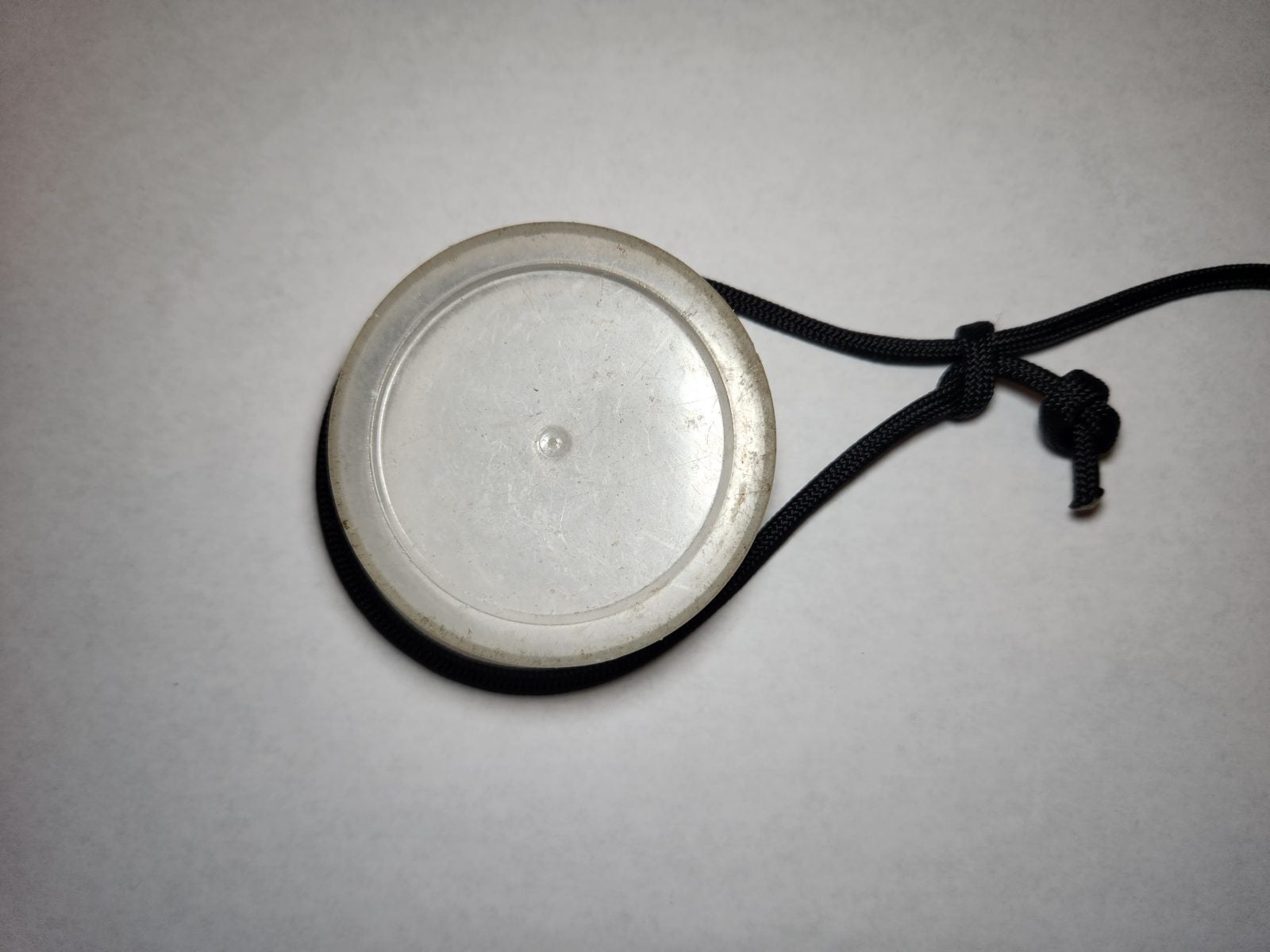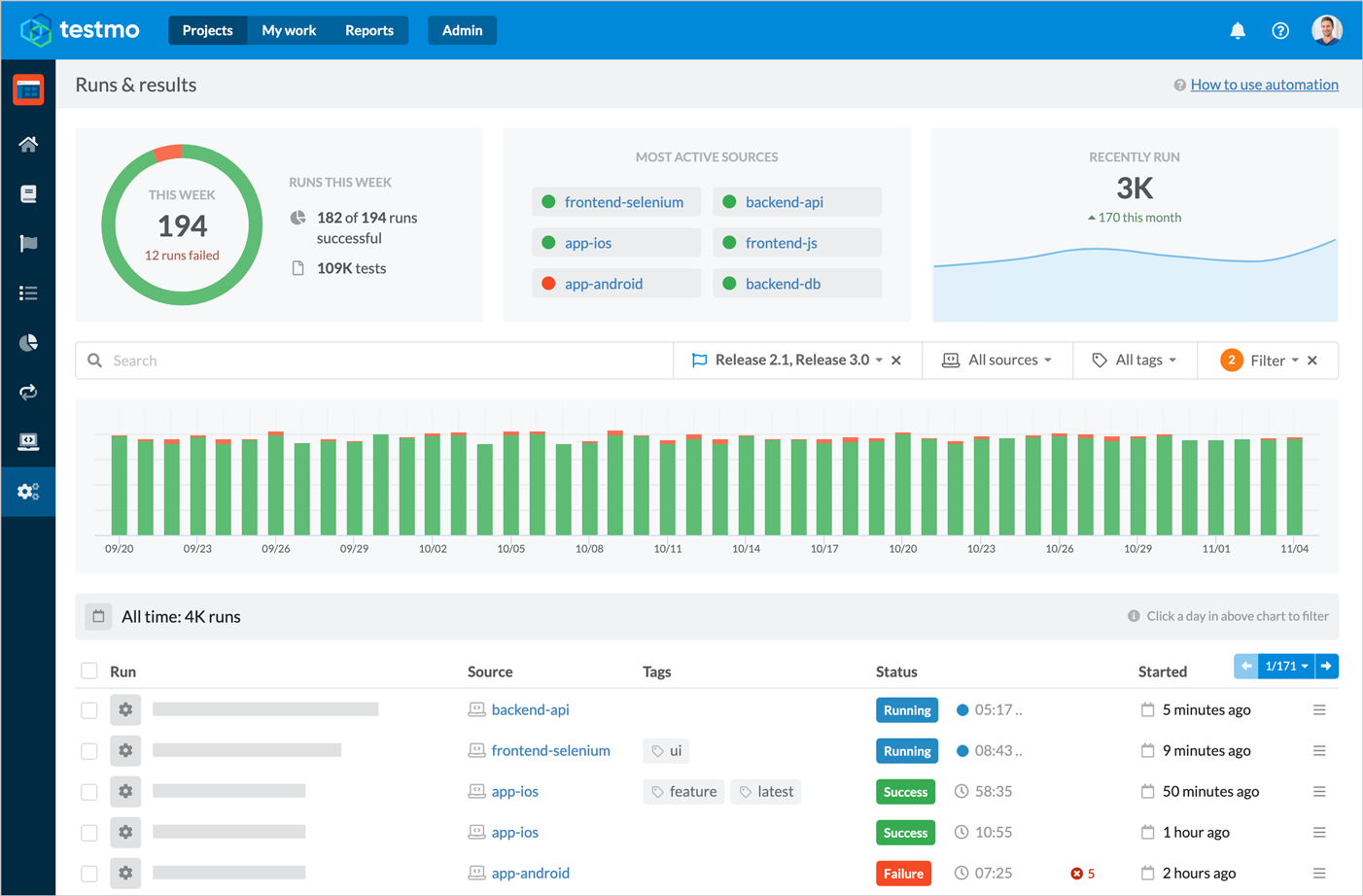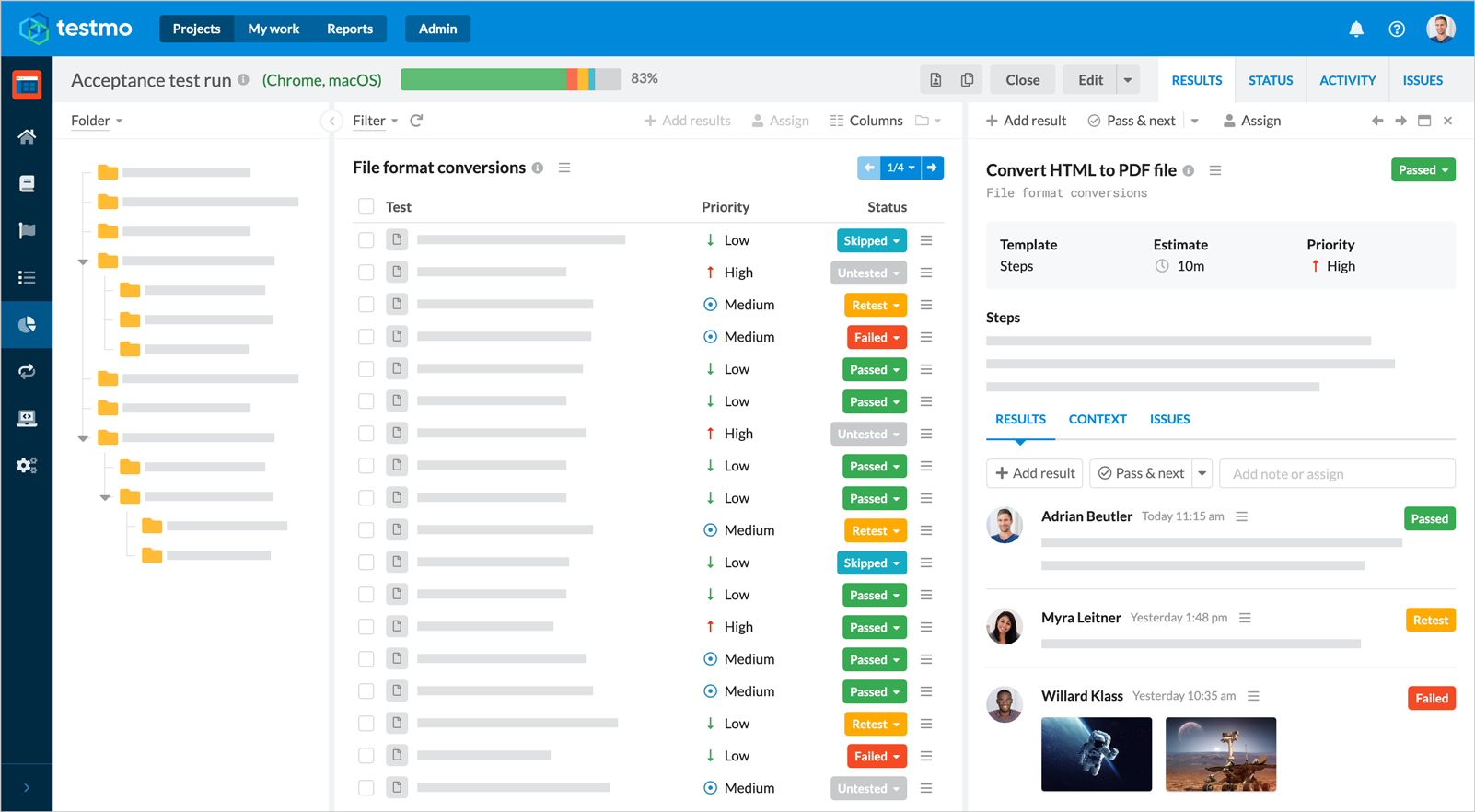https://cdn.athlonoutdoors.com/wp-content/uploads/sites/8/2022/11/FN-502.jpg
Every year, the firearms industry launches a variety of new guns for the market. It is usually a spectrum of new blasters that range from high-end bolt guns and ARs to special shotguns and pistols. While small themes have appeared in the past, they have been centered on a small sector of the industry. That changed this year, as multiple companies decided to hop on the .22 rimfire bandwagon. In the past, these guns were not anything new, and each year we saw a new plinker hit the market.
Best New .22 Pistols for 2022
This year though, we have seen major companies build serious guns chambered in our beloved .22 LR. They are well designed and, in almost all cases, designed to mimic a full-size gun in their lineup. The benefits of this design are numerous, and they have been warmly welcomed by the shooting public. While there have been many released in this space, there are three that have really stood out.
FN 502 Tactical

While some may argue this, it is my opinion that the release of the FN 502 Tactical really started this “tactical .22” trend. The FN 502 Tactical is the first .22 LR from FN and is the industry’s first slide-mounted, optics-ready rimfire handgun that has ever existed. This is truly a tactical plinker. FN really started this “tactical pistol” trend with the FNX Tactical chambered in .45 ACP all those years ago. The FN 502 follows that DNA and represents a new trend in guns designed for training. The gun is a product of a partnership with Umarex based in Germany. While some know Umarex for their air guns, they have extensive experience in the .22 rimfire world. FN worked closely with Umarex during the design and engineering process and ended up with a gun that meets what people expect from an FN pistol.
This hammer-fired .22 LR comes optic ready with a threaded barrel to mount your suppressor. Many of you recognize the gun as very close in appearance and size to its big brother, the FN 509. Like its centerfire counterpart, the FN 502 has solid ergonomics as well as ambidextrous controls. The slide is aircraft-grade anodized aluminum and steel. It has well-designed front and rear cocking serrations for easy manipulation as well as a loaded chamber indicator. In that FN designed the gun to run optics and a can, it comes with suppressor-height fixed front and rear sights. It ships with both 10-round and 15-round magazines. This is essentially a full-size gun and fits in most holsters made for the 509. This is not an accident, as the 502 is designed to be a rimfire trainer.
Rounds Downrange
On the range, the FN 502 lives up to the hype. The gun has a full-size feel while running the soft-shooting .22 LR round. While the trigger is officially listed at 5 pounds, the gun I had broke well under 4 pounds. The trigger is one area that is different from the 509 and, by necessity, because of design. It is a bit long but not a deal breaker. I ran a variety of ammo including Federal 36-grain CCI Clean-22 and Aguila Sniper subsonic. Each of these flavors ran well in the 502, and I had no issues.
I also ran it suppressed, and the gun continued to run. A quick disassembly following the range session showed that while the FN 502 is a “tactical trainer,” it is still a .22 and was filthy inside. This was compounded by my extensive use of a suppressor. No worries though, as it cleaned up easily. I give the FN 502 high marks and tip my hat to FN for really pushing the tactical trainer market. (fnamerica.com)
Sig Sauer P322

Next in our lineup is the Sig P322. Like FN’s offering, the P322 is a tactical-style, optics-ready pistol with a threaded barrel. Sig has come up with 21 reasons to own this gun, but I will break it down to what I feel are the most important. First up, the gun has a 21-round capacity. The gun comes with two easy-to-load 20-round mags, and Sig also included a mag loader. Optics-wise, the gun is cut to fit all the most common micro red-dots including the Sig Romeo Zero.
Unlike the FN, the Sig P322 uses a threaded barrel adapter. To move to the threaded option, the low-profile thread protector on the barrel is unscrewed, and the threaded adapter is put in its place. It is a very simple and reliable design that will allow you to run your new .22 suppressed. Adding a suppressor does not affect performance at all. When Sig did their testing on the gun, they ran a wide variety of suppressors to make sure it did not affect performance.
Some of the other features include a 1913 rail, manual safety, ambidextrous controls and well-designed cocking serrations. One of the most interesting things about the gun is its ability to use either a flat face trigger or a traditional rounded version. Sig includes both with the gun, and they are very easy to switch out. They are essentially a face that sits on a metal trigger frame. The P322 has a fixed barrel, which improves accuracy. With that, Sig has included an adjustable rear sight to help you fine-tune your gun.
Ergonomic Design
The P322 has an ergonomic design and is easy to disassemble. With an eye on lifespan as well as recoil reduction, Sig has made the frame from stainless steel. With a stainless steel frame, the obvious balance for weight was to make the slide out of aluminum. This does help keep the gun light yet durable. In fact, it is an aluminum alloy that helps increase the long-term life of the slide. Simply put, you will not wear out the slide. The gun also has a well-designed and fast integrated mag well.
Performance-wise, the gun is a shooter. The P322 is designed to run 1,000 rounds between stoppages. Sig even has a designated testing gun that is at 24,000 rounds and still running. The key to all this is a fluted barrel that allows the P322 to eat anything you feed it. I ran the same ammo in the Sig as I did with the FN and had the same results. The lightweight nature of the gun made it very fast and easy to shoot. When suppressed, it became “Hollywood” quiet and still ran fine. The P322 is everything you would expect from Sig. It has a close resemblance to the P320 and handles like a full-size gun. The P322 is a solid choice for not only training but enjoyable range time as well. (sigsauer.com)
Walther WMP
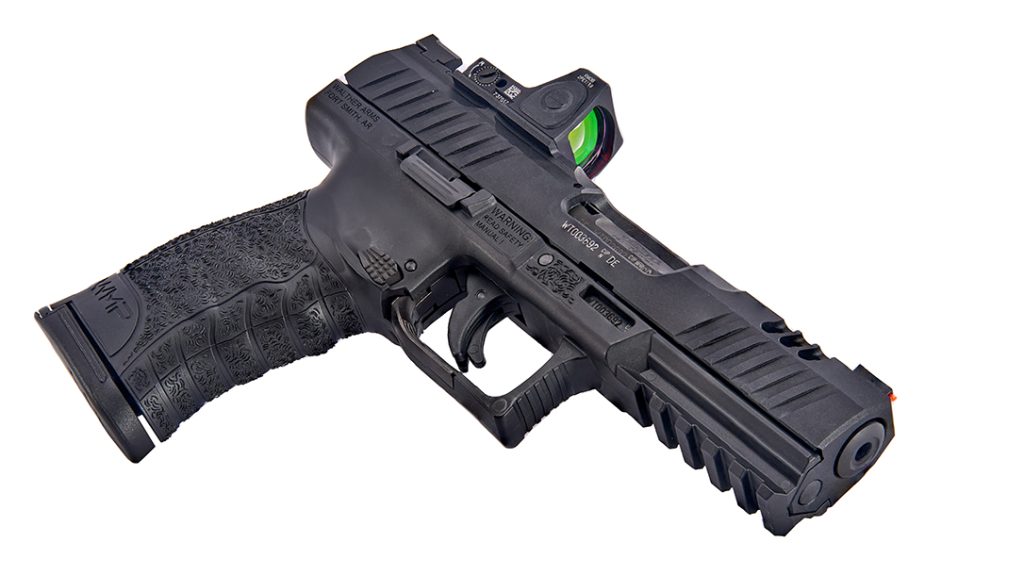
The last in our trio of .22s is the Walther WMP. This gun is a little bit of a departure from our previous two guns because we move from .22 LR to .22 WMR. This new pistol starts to cross over into a more serious caliber that some consider viable for personal protection. That debate will have to wait for another day, but the new WMP is a very nice gun. Like our other guns, the WMP is optics ready. I was disappointed to note it did not come with a threaded barrel, but it is obviously not a deal breaker. For those familiar with Walther, you will recognize the ambidextrous triggerguard magazine release.
Walther has gone a step further though and made a patented mag release mechanism that uses both a paddle release and a button release. This is a 15+1 capacity gun and comes with two magazines in the box. The Walther WMP features a lightweight machined slide that is made of premium 7075 aluminum, reducing the pistol’s weight and making it very comfortable to carry. Sight-wise, the WMP features a fiber-optic front sight and a serrated rear sight. The pistol comes with two different height rear sights to change the point of impact if needed. Like the Sig, the gun’s chamber has been fluted to work across a wider variety of ammunition types. Lastly, the trigger is a good double-action design that features Walther’s trigger safety.
Fun to Shoot
On the range, the gun was very enjoyable to shoot. Compared to its .22 LR range mates, the WMR had significantly more punch. Running a Trijicon RMR seemed to be the perfect fit for this gun. While I was not hard focused on testing for groups, I did take time to see what I could get. I was pleasantly surprised with a 1.5-inch group at 25 yards. The gun ran well, and I fed it CCI Maxi-Mag 40 grain. I had no malfunctions during the testing but know of some issues other writers have had.
Walther provides a recommended ammo list on their website, and I encourage you to follow it. While I would prefer a gun that runs everything, the .22 ammo market is a weird creature sometimes that makes it hard for gun companies to work around. The Walther WMP is a very enjoyable gun to run and would make a great addition to anyone’s collection.
The .22 pistol market has grown up and is no longer just the place for plinkers. These three guns are serious and allow us to get trigger time at a fraction of the cost we see with standard guns. They are well made and are great training options. On top of that, they are fun to shoot and can be a great way to teach people to shoot. As Phil Strader, director of Firearms Product Management at Sig, shared with me, “This is a gateway gun.” While he was referring to the P322, the same holds true for all these pistols. (waltherarms.com)
FN 502 Specs
- Caliber: .22 LR
- Barrel Length: 4.6 inches
- OA Length: 7.6 inches
- Weight: 23.7 ounces (empty)
- Grips: Polymer
- Sights: Suppressor-height, fixed front and rear
- Action: Semi-auto
- Capacity: 10+1, 15+1
- MSRP: $519
Sig Sauer P322 Specs
- Caliber: .22 LR
- Barrel Length: 4 inches
- OA Length: 7 inches
- Weight: ounces 17.1 ounces (empty)
- Grips: Polymer
- Sights: Fiber-optic front, adjustable rear
- Action: Semi-auto
- Capacity: 20+1
- MSRP: $399
Walther WMP Specs
- Caliber: .22 WMR
- Barrel Length: 4.5 inches
- OA Length: 8.2 inches
- Weight: 27.8 ounces (empty)
- Grips: Polymer
- Sights: Fiber-optic front, serrated rear
- Action: Semi-auto
- Capacity: 15+1
- MSRP: $549
THE .22 HITS KEEP ON COMING IN 2022
Browning Buck Mark Plus Vision Black/Gold Suppressor Ready
The Browning Buck Mark Plus Vision Black/Gold Suppressor Ready is a good-looking .22 LR pistol. Its good looks are based on the mix of a black frame and a gold Cerakote barrel. The gun features a green TruGlo/Marble Arms fiber-optic front sight, a gold-plated trigger and a superb black radial ported muzzle brake. The gun uses straight blowback, recoil-operated engineering. The barrel runs 5.88 inches long and is suppressor ready. The gun’s hexagonal-cut sleeve encapsulates the narrower diameter barrel.
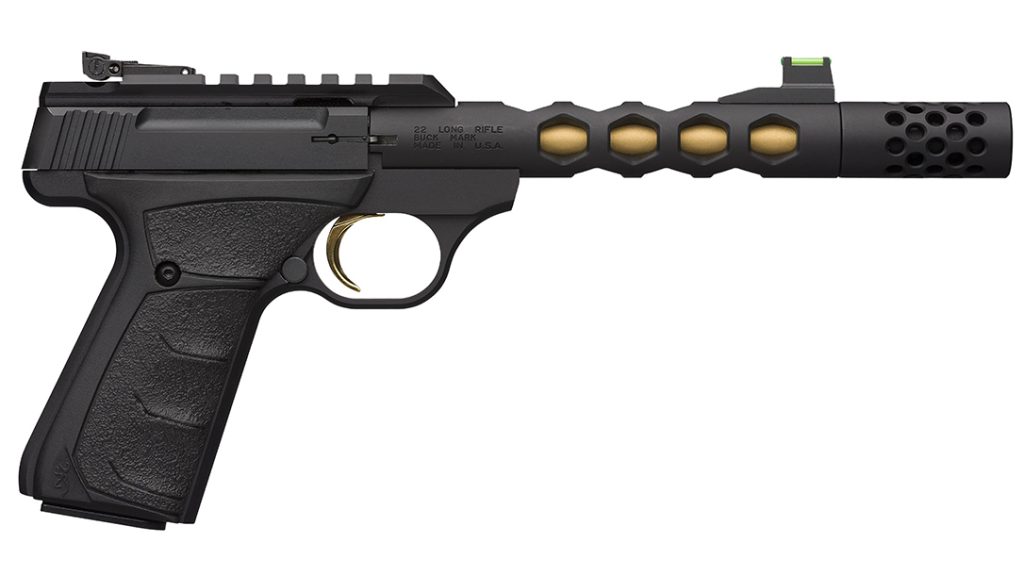
The gun’s weight is minimal at just 27 ounces and is 9.9 inches long overall. The pistol has many ergonomic touches. The slide even features protruding grip wings behind the serrations for easier racking. The Picatinny rail slide top, thread protector and trigger’s inner curve are all serrated either for glare-cutting or a better grip. The matte black racetrack oval alloy triggerguard has an ergonomic undercut behind it with an ambidextrous magazine release just above that. The short-pull trigger is gold plated alloy, echoing the gold Buck Mark under the triggerguard. The gun shoots as good as it looks. (browning.com)
- Caliber: .22 LR
- Barrel: 5.88 inches
- OA Length: 9.9 inches
- Weight: 27 ounces (empty)
- Sights: Fiber-optic front, white outline pro target rear
- Grips: Polymer
- Finish: Black anodized
- Capacity: 10 rounds
- MSRP: $779
Charter Arms Target Pathfinder
The new Target Pathfinder is a great introductory revolver for the novice shooter or anyone who needs a low-recoil revolver. It has the look, feel and weight of a higher-caliber revolver, allowing you to gain proficiency while using relatively inexpensive .22 ammo.

The .22 Pathfinder can turn a few tin cans into an afternoon of fun. As with other 22s, it is equally effective at eliminating pests. Its stainless finish with black rubber grips with finger grooves rounds out the overall aesthetic. (charterarms.com)
- Caliber: .22 LR
- Barrel: 4.2 inches
- OA Length: 9.07 inches
- Weight: 24 ounces (empty)
- Sights: Ramp front with a wide post, adjustable rear
- Grips: Rubber with finger grooves
- Finish: Anodized/stainless steel
- Capacity: 8
- MSRP: $426
Colt King Cobra Target .22
One of the most iconic revolvers of all time is the Colt Python. In fact, their entire line of “snake” guns is considered the gold standard of wheelguns. Well, the snake lovers now have a new gun to add to the collection. Colt has launched the King Cobra Target .22 LR, bringing a competition, plinking and game-getting revolver to the market. The King Cobra Target packs 10 rounds of .22 LR into its cylinder. The gun fits a variety of applications and is equally capable on the farm or in competition The one-piece stainless steel barrel delivers accuracy as well, according to Colt. It comes topped with an adjustable target rear sight and fiber-optic front sight and is fitted with Hogue overmolded rubber grips. The King Cobra Target in .22 LR comes fitted with either a 4- or 6-inch barrel and has the classic stainless finish. (colt.com)

- Caliber: .22 LR
- Barrel: 4 and 6 inches
- OA Length: 11.5 inches
- Weight: 32 ounces (empty)
- Sights: Fiber-optic front, adjustable rear
- Grips: Hogue
- Finish: Stainless
- Capacity: 10 rounds
- MSRP: $999
Heritage Rough Rider Tactical Cowboy
Heritage says it best when they said, ”For making tin cans dance in the backyard, pinging steel, or controlling pests and varmints around the farm, nothing beats the low-cost, high-adrenaline thrill of a single-action rimfire revolver.” Heritage Rough Rider Tactical Cowboy fits that role perfectly. While chambered in .22 LR, it is also compatible with the .22 WMR cylinder, allowing you to shoot either .22 LR or .22 WMR ammo. The new Heritage Rough Rider Tactical Cowboy features modern-day technology into an old classic world design. The barrel is threaded for accessories like compensators and suppressors. The Picatinny rail allows the user to add different optics if desired but also works as a rear open sight to be used with the bright front fiber-optic sight. (heritagemfg.com)

- Caliber: .22 LR
- Barrel: 6.5 inches
- OA Length: 11.85 inches
- Weight: 32.1 ounces (empty)
- Sights: Fiber-optic front, rear Picatinny rail
- Grips: Carbon fiber
- Finish: Black standard
- Capacity: 6
- MSRP: $213
KelTec CP33
KelTec felt the .22 market needed an update, so they released the CP33. CP stands for Competition Pistol, and 33 because it holds a staggering 33 rounds in the magazine. Equipped with a Picatinny-style top rail and a Magpul M-Lok slot built into the dust cover, the CP33 is ready to accept your favorite optics and accessories. Train, compete, plink and repeat. If you’d like to do it quietly, simply attach your favorite .22 suppressor. As ambidextrous as this handgun can be, the CP33 offers a safety lever on both sides of the grip, a heel catch magazine release and a unique charging handle located at the back of the receiver. Adjustable fiber-optic sights, a 9-inch sight radius and threaded barrel come standard, making short work of bullseyes and other targets. (keltecweapons.com)
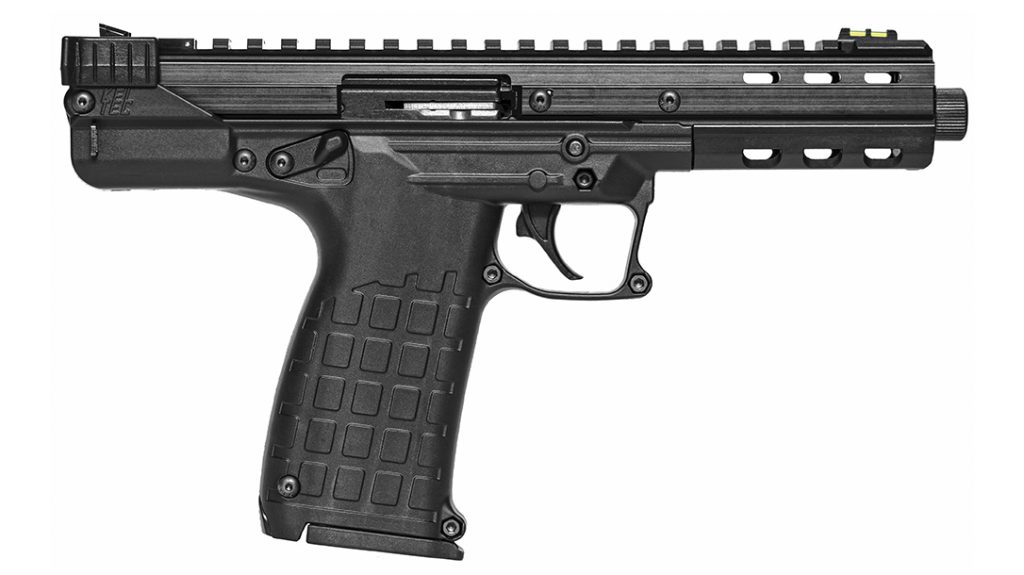
- Caliber: .22 LR
- Barrel: 5.5 inches
- OA Length: 10.6 inches
- Weight: 1.5 pounds (empty)
- Sights: Adjustable fiber optics
- Grips: Polymer
- Finish: Anodized
- Capacity: 33+1
- MSRP: $600
Ruger Mark IV 22/45 Lite
Let’s take a look at Ruger’s new Mark IV 22/45 Lite. This is a small and versatile .22 LR pistol built to fill a variety of needs. If you’re looking for a rimfire pistol for Steel Challenge, a .22 LR to mount a suppressor on or just something to plink with at the range, you may be interested in picking one up. The Mark IV line of Ruger pistols was introduced in 2016 and is the fourth-generation successor of the Ruger Standard. This pistol is yet another extension of Ruger’s popular .22 pistol lineup. Accurate, fun to shoot and reliable, the Mark IV 22/45 Lite promises to be a solid part of the Ruger legacy. (ruger.com)

- Caliber: .22 LR
- Barrel: 4.4 inches
- OA Length: 8.4 inches
- Weight: 25 ounces (empty)
- Sights: Blade front, adjustable rear
- Grips: Polymer
- Finish: Anodized
- Capacity: 10+1
- MSRP: $699
Ruger Wrangler 2016 Birdshead Revolver
When you think of .22 wheelguns, one of the first companies to come to mind is Ruger. This year, Ruger is adding to its Wrangler single-action .22 Long Rifle revolver line with a more compact version featuring a gracefully curved birdshead grip, smooth black polymer grip panels and a barrel that has been shortened from 4.62 inches to 3.75 inches. This gun is based on the company’s six-shot Single-Six and similarly features steel cylinders and cold-hammer-forged steel barrels. The revolver is offered in a variety of colors with a black, silver or burnt bronze Cerakote finish. A transfer-bar safety system and a loading gate interlock safety guard against unintentional discharges. Wranglers employ the same classic blade front sights and fixed notch rear sights found on Ruger’s Vaquero and Bearcat models. It is a great new member of their lineup. (ruger.com)

- Caliber: .22 LR
- Barrel: 3.75 inches
- OA Length: 8.62 inches
- Weight: 28 ounces (empty)
- Sights: Blade front, integral rear
- Grips: Synthetic
- Finish: Silver Cerakote
- Capacity: 6
- MSRP: $279
Standard Mfg. SG22
Standard Manufacturing brings a classic look back to life with their SG22. This new .22 LR semi-automatic pistol is reminiscent of the well-loved Colt Woodsman. This beautiful gun possesses the classic styling and design elements of the quintessential guns of yesteryear. The Standard SG22 features a button magazine release, target grips and sights, which make it ideal for target shooting. A 6.62-inch barrel allows for superb accuracy and handling. If you are looking for a classic look with the benefits of modern manufacturing, Standard’s SG22 needs to be on your list. (stdgun.com)

- Caliber: .22 LR
- Barrel: 6.62 inches
- OA Length: 10 inches
- Weight: 30 ounces (empty)
- Sights: Blade front, adjustable rear
- Grips: Walnut
- Finish: Blued
- Capacity: 10+1
- MSRP: $1,099
S&W 317 Kit Gun
Smith & Wesson J-Frame revolvers have been around since 1950. These small revolvers were designed to fire a full-power round and are as simple and easy to use as they are reliable. Available in various calibers and with three diverse hammer designs, it is no surprise that the Smith & Wesson J-Frame has become the most popular small-frame defense revolver on the market. Now you can get that J-Frame happiness in .22 LR with the 317. Built on an aluminum-alloy J-frame and chambered in .22 Long Rifle, this lightweight revolver is small enough to be carried inside a hunter or fisherman’s kit bag, as its name suggests. It is a classic S&W J-Frame and enjoyable to shoot. (smith-wesson.com)

- Caliber: .22 LR
- Barrel: 3 inches
- OA Length: 7.19 inches
- Weight: 11.7 ounces (empty)
- Sights: HI-VIZ fiber-optic green front, adjustable rear
- Grips: Synthetic
- Finish: Matte silver and stainless
- Capacity: 8
- MSRP: $826
Taurus TX 22 Competition
Taurus enters the field with their TX 22 Competition. This full-size, semi-auto rimfire was re-engineered by Taurus to meet your most rigorous performance demands. The upgraded, optics-ready slide and 5-inch threaded bull barrel assembly bring match-grade accuracy and versatility to any shooting discipline, giving today’s competitive shooters the unique opportunity to shatter records without breaking the bank. While built with competition in mind, the gun is equally as much fun on the range shooting cans. (taurususa.com)

- Caliber: .22 LR
- Barrel: 5 inches
- OA Length: 8.15 inches
- Weight: 23 ounces (empty)
- Sights: Fixed white-dot front, adjustable rear white dot
- Grips: Polymer
- Finish: Hard anodize
- Capacity: 16+1/10+1
- MSRP: $589
This article originally appeared in the September-October issue of Tactical Life magazine. Get your copy or subscribe at OutdoorGroupStore.com.

The post The 13 Best New .22 Pistols to Hit the Market in 2022 appeared first on Tactical Life Gun Magazine: Gun News and Gun Reviews.
Tactical Life Gun Magazine: Gun News and Gun Reviews
